Corona Fear: How Japan is Coping
Top Image: danielbichler on Pixabay
2020 will be defined by any number of things, but no doubt the COVID-19 pandemic will be at the top of the list. For the better part the year, the entire world has been in the grip of an invisible menace that medical workers around the globe have worked tirelessly to combat.
Japan was one of the first countries hit by the coronavirus, and while the danger is nowhere near over, it has been comparatively fortunate in how it has managed as of Fall 2020. There are a number of reasons for this, but here are a few that we feel contributed:
Unified Caution
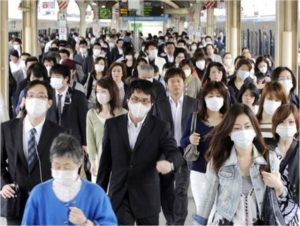
Once the State of Emergency was announced, nearly all of the Japanese public put in masks when exiting their homes. Photo Credit: (Associated Press / The Spokesman-Review)
From the first day that the threat of the coronavirus became truly serious, the majority of the country took the threat seriously and took precautionary steps to prevent the spread. People who didn’t need to go out stayed home, wore masks, used hand sanitizer, didn’t gather in large groups, practiced proper social distancing, etc. There were very few, if any, voices of dissent in this protocol. While some have emerged over time, the general attitude was one of unity. Why is this?
Cultural Predisposition
Japan’s is a culture that values cleanliness, be it the washing of hands and mouth when entering the grounds of a shrine or temple, or the custom of a dip in the onsen. While Japan isn’t alone in this, the wearing of masks to prevent the spread of germs is such a common sight year-round that it feels more like an expectation than an aberration. It was seen as no burden by most people to do so for a longer period of time, especially with the mutual benefits of self-protection.
Likewise, when the government asked that citizens put their weekend plans on hold and avoid mass gatherings, the majority of the populous was more than happy to comply. Some may view this passive approach critically, but at the end of the day, the fact is people stayed or worked from home when they needed to, to the point where the ‘restrictions’ have begun to ease across the country.
Sensible Independence
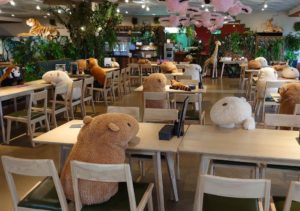
A café enforces social distancing while still operating. Photo Credit: Twitter user @chacha0rca
For those from overseas, of the most challenging things about this pandemic has been hearing about friends and loved ones suffering back home with their jobs. It’s been difficult to hear about how people were forced to close their businesses that they operate to provide for themselves and their families, even when they could easily run their businesses safely by taking the proper steps to prevent the spread of the virus.
That’s why many of us have been incredibly impressed and proud of how Japan largely refrained from forcing closures, instead relying on an ‘honor system’ of strong requests. This allowed for business owners to take precautions to prevent the spread of the virus while also maintaining their livelihoods.
In Conclusion (for now…)
Of course, it is up for debate just how successful overall Japan’s management of COVID-19 has been, especially with the situation still ongoing. We can only speak from our own personal experience, and the unfortunate reality is that not everyone’s has been positive during these difficult times. We do not mean to trivialize the experiences of those less fortunate; only to offer our thoughts on our own.
For all those looking to one day travel to Japan, we hope that not only will that time be sooner rather than later, but that you’ll also be able to see how the people’s handling of this crisis has allowed Japan to continue on with life changed perhaps, but not irrevocably damaged. For now, the only true certainty is that we have hope that life for people all over the planet will improve as we enter into a new year.
Additional research and photos for this article were provided by Connor Steck. Cover photo provided by Daniel Bichler via pixabay.com.
Photo Credits:
Top Image: danielbichler on Pixabay
Additional research and photos for this article were provided by Connor Steck. Images courtesy of (1) Associated Press / The Spokesman-Review and (2) Twitter user @chacha0rca
All other content (text) created by the original author and © 2020 MUSUBI by Borderlink
Are you a fan of food? Who isn’t, right? Let me put it another way:
Do you enjoy thick, scrumptious noodles? Do you love robust, savory flavors? Does the thought of gut-busting portion sizes make your mouth water?
If you answered “yes” to any of these questions, then I’d like to welcome you to the world of Jiro-style ramen.
A Brief History of Time (and Ramen)
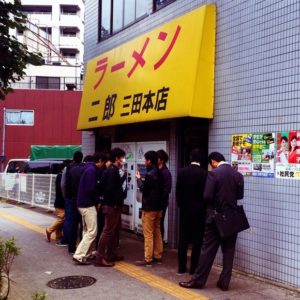
The original Ramen Jiro, a holy place for fans.
Now, most of you are probably thinking, “I know what ramen is, but what’s Jiro mean?” I’m glad you asked! Back in 1968, an entrepreneur by the name of Takumi Yamada opened a ramen shop in Meguro, Tokyo called Ramen Jiro.
Initially, the shop served a thinner, lighter style of ramen typical of your average Japanese ramen stand. However, thanks to the help of a neighboring Chinese restaurant, Yamada developed a new, distinctive taste that became known as “Jirorian style”; a fatty, salty shoyu (soy sauce) and tonkotsu (pork bone) soup base with thick, dense noodles and juicy pork chunks.
In the early 1970’s, the first Ramen Jiro moved to Mita, Tokyo. It quickly gained popularity among Keio University students due to its close proximity. In fact, when the restaurant was again forced to move in 1995, students petitioned to have it be on-campus, though it would ultimately relocate to a different part of Mita.
Now, Ramen Jiro has approximately 40 locations across Japan, over 30 of which are in the greater Tokyo area. Ramen Jiro fanatics known as “Jirorians” seek out Jiro-style ramen regularly, and often make pacts to visit all 40 Ramen Jiro locations across the country. The original Mita shop is regarded as “the sacred place” and if you’re thinking about trying Jiro-style ramen for the first time, it’s as good a place as any to visit.
The Secret’s in the Soup
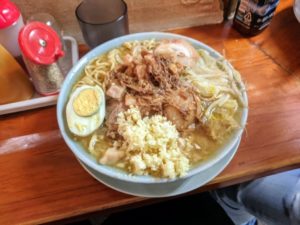
A typical bowl of Jiro-style ramen.
Now that you know the history of Jiro-style ramen and have a basic understanding of what it is, it’s time to get into details. It is my belief that for all types of ramen, the most important part of the dish is the soup. This is especially true of Jiro-style, which requires lengthy preparation. First, pork bones are boiled for hours to make the base. Ingredients such as pork fat, Japanese leeks, ginger, garlic, and cabbage are added throughout the process. Lastly, umami (‘savory taste’) seasoning is used during the plating process to complete the thick and hearty soup.
Next, let’s talk noodles. Restaurants vary in terms of whether they make their noodles in-house (the best option, in my humble opinion) or order them from an outside source, but one thing remains consistent: the thickness. Jiro-style ramen noodles are long, thick, and extremely hearty. A normal-sized portion will typically have about 200 grams of noodles in it.
Most Jiro-style places will have small, medium, and large portions, but sometimes a restaurant will have just regular or large. In such cases you can usually order a half-portion and they will give to an extra topping for free as compensation for losing the noodles at a normal-portion price.
Simply Topping!
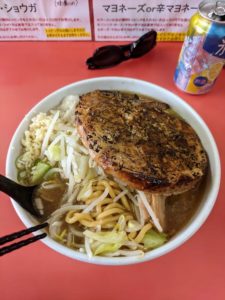
A bowl from my local Jiro-style joint, complete with “Texas Steak”.
Finally, it’s time to talk about the fixings. This is where the individual flair of a Jiro-style ramen place comes into play. The typical toppings are vegetables (typically a mix of cabbage and bean sprouts) in large quantity and one to two slices of chashu (seasoned pork belly).
Now here’s where things get interesting. One of the traits unique to Jiro-style is the ability to purchase special toppings for the dish and to tell the chef what extra free toppings you want added to the bowl during plating.
These toppings are usually listed at the restaurant and are told to the chef after prompting from them. Typical toppings include garlic, more vegetable mix, karame (a spicy sauce), or more pig fat. All toppings are available to be added in any combination and even in double amounts. There are also various other toppings available depending on the location, like boiled eggs, special dipping sauces, raw egg, and even mini season pork steaks. The result is the ability to create a customized and truly formidable dish of epic proportions.
Join the Jirorians Today!
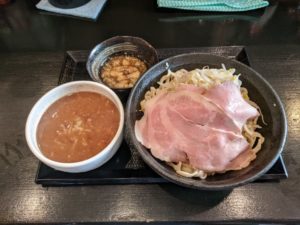
Jiro-style tsukemen.
The popularity of Jiro-style ramen has also given birth to the creation of other noodle dishes adjacent to ramen, such as Jiro-style tsukemen (cold noodles with a dipping sauce/soup) and mazesoba (a Taiwan-style dry noodle dish). Taking cues from the Jiro-style ramen, each dish follows their respective traditional fashions, but incorporates the Jiro-style portion sizes, flavors, and variety of toppings. Additionally, many ramen restaurants (with no affiliation to Ramen Jiro) have since come into existence, making their own Jiro-style ramen.
Jiro-style ramen is not for the faint of heart. Its hefty portion sizes and strong flavors can be daunting and have overwhelmed many a customer. A small-sized bowl of it has around 1600 kcal, whereas the average small-sized bowl at a typical Japanese ramen shop contains about 600 kcal. Due to this style of ramen being high in carbohydrates and fats with little nutritional value, it is often described as a ‘junk food’ by critics.
However, it is a truly unique dish that should be tried at least once in a lifetime if you are given the chance to do so. And who knows? You too could become a Jirorian of the Church of Ramen Jiro like I have.
Photo Credits:
Additional photos provided by Connor Steck
All other content (text) created by the original author and © 2020 MUSUBI by Borderlink
Top Image: leolevng on Pixabay
A brief trip around the Osaka and Kashihara areas, and the ancient treasures one can find there if they look.
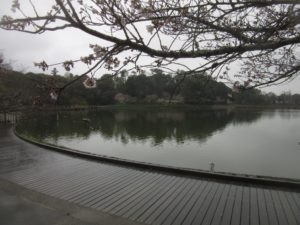 The United States is only a little over two hundred years old. Australia has been an independent nation for just over one hundred years. England may be said to be just over one thousand years old. Japan has them all beat—it marks its “Foundation Day” on February 11th for when the country ‘began’ back in 660 BC. So, as you might expect, an American like myself constantly finds reasons to be astonished at how the distant past lives side by side with the present in Japan.
The United States is only a little over two hundred years old. Australia has been an independent nation for just over one hundred years. England may be said to be just over one thousand years old. Japan has them all beat—it marks its “Foundation Day” on February 11th for when the country ‘began’ back in 660 BC. So, as you might expect, an American like myself constantly finds reasons to be astonished at how the distant past lives side by side with the present in Japan.
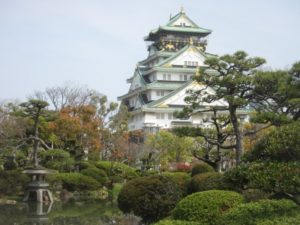 Osaka is home to the eponymous Osaka Castle, constructed in the 16th century. Many pieces of stonework at the site date back to the original castle, but the main tower that stands today is a replica built in 1931. This landmark is certainly worthy of a visit and a reminder of what the country was like over four hundred years ago.
Osaka is home to the eponymous Osaka Castle, constructed in the 16th century. Many pieces of stonework at the site date back to the original castle, but the main tower that stands today is a replica built in 1931. This landmark is certainly worthy of a visit and a reminder of what the country was like over four hundred years ago.
But, for something even more ancient, I was surprised to find that just one train stop away from where I live in Kashihara is the country’s old 6th century capital, Asuka. Although there are strict rules about construction in the area, any traveler will be astounded at the proximity of vibrant, friendly neighborhoods to the fourteen-hundred year-old burial mounds.
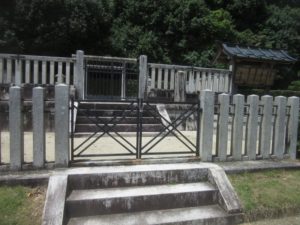 Visitors to the nearby museum may also have a look at several beautiful murals that have been uncovered and preserved by archaeologists. Strolling through Kashihara neighborhoods, one may see households built to beautiful, traditional notions of aesthetics, some of them dating back to the 19th century. In between the homes, a very common sight is food crops.
Visitors to the nearby museum may also have a look at several beautiful murals that have been uncovered and preserved by archaeologists. Strolling through Kashihara neighborhoods, one may see households built to beautiful, traditional notions of aesthetics, some of them dating back to the 19th century. In between the homes, a very common sight is food crops.
Farms in the area mostly grow rice, but also a variety of vegetables like daikon (Japanese radish), cabbage, and potatoes. Today, the people here depend on their own efforts in much the same way they did hundreds of years ago, growing food for themselves and to sell at local markets. It’s no wonder the food here is so good- the locals pour their heart and soul into the area they live.
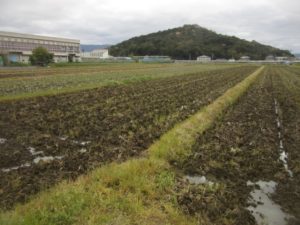 For anyone hungering for a place where a connection to the past is always palpable, you don’t have to look far in Japan. Whether in its monuments, its landmarks, its people or the produce, history is very much a part of daily life in this beautiful country.
For anyone hungering for a place where a connection to the past is always palpable, you don’t have to look far in Japan. Whether in its monuments, its landmarks, its people or the produce, history is very much a part of daily life in this beautiful country.
Photo Credits:
Top Image: leolevng on Pixabay
Additional photos provided by Adam Marshall
All other content (text) created by the original author and © 2020 MUSUBI by Borderlink
Top Image Courtesy of Kristine Mayor

Image Courtesy of stevepb via Pixabay https://pixabay.com/photos/thermometer-medications-tablets-1539191/
When it comes to first aid in the home, it’s always best to be prepared with a well-stocked medicine cabinet. This way if you need to treat an illness or injury, you’ll have all the common medications and first aid supplies on hand to help yourself or others.
In Japan, there are many over-the-counter drugs in pharmacies, drugstores and some convenience stores. You can easily find such stores around stations or in shopping centers. These stores are generally open 7 days a week, and sometimes 24 hours a day, like Welcia or Matsumotokiyoshi.
Buying medicine in Japan can be a daunting task for first-timers, so here’s a brief guide to some basic must-haves for common ailments. When in doubt though, it never hurts to ask what the best medication for you may be.
PAIN / HEADACHES AND FEVER
• バファリン (Bufferin)
Indication:
Pain relieving effect on headache, pain due to stiff shoulders, menstrual pain, back pain, joint pain, neuralgia, muscle pain, sore throat, toothache, pain after tooth extraction, pain from bruising, pain from sprains, pain from bone fractures, pain from trauma and earache. Reducing effect on chills and fevers
Dosage: Avoid taking on an empty stomach and wait at least four hours between doses.
Take the following amount with lukewarm or cold water.
Age /Amount per 1 dose / Doses per day
Adults (15 years and up) / 2 tablets / No more than 3
Children under 15 years / Do not use / Do not use
• イブ (Eve)
Indication:
Relief of pain associated with headache, stiff-shoulders, toothache, menstruation, sore throat, joints, muscles, neuralgia, lower-back, tooth extraction, bruising, earache, bone fracture, sprains and wounds. Fever reduction, relief from chills due to fever.
Dosage: Take the following dose up to 2 times a day, at intervals of at least 6 hours, avoid taking on an empty stomach. This drug should be taken with either cold or lukewarm water.
Age /Amount per 1 dose / Doses per day
Adults (15 years and over): 2 tablets
Children under 15 years of age: DO NOT TAKE.
STOMACH PAIN/INTESTINAL
• 胃腸薬 (Icho yaku)
Indications:
Stomach pain, bloating, heartburn, gastric hyperacidity, belching, feeling of heaviness in the stomach, feeling of excessive fullness in the stomach, stomach discomfort, esophageal discomfort, stomach trouble caused by excessive alcohol consumption, nausea (queasiness, nausea due to hangover or alcohol consumption, upset stomach, retching, feeling of sickness), vomiting
Dosage: Take the following amount between meals* and before bed with warm or cold water.
*2 to 3 hours after eating, when most food has left the stomach.
Age /Amount per 1 dose / Doses per day
Adults (15 years and over): 1 sachet
Children under 15 years of age: DO NOT TAKE.
• 下痢止め (Geridome)
Indication:
Relief of the following symptoms: diarrhea, food poisoning, water poisoning, loose stool, abdominal pain.
Dosage: The maximum dose frequency is 3 times a day at intervals of 4 hours or longer.
Adults (15 years and over): Take 1 tablet at a time by chewing or by dissolving in the mouth.
COLD AND FLU MEDICINE
• パブロン (Paburon)
Indication
Relief of various symptoms of a common cold: running nose, stuffy nose, sneezing, sore throat, cough, phlegm (sputum), chills (feeling cold due to fever), fever, headache, joint pain, and muscle pain.
Dosage
Take the following dose with cold or lukewarm water within 30 minutes after a meal whenever possible.
15 years or over: 3 tablets per dose, 3 times daily
Children aged 12~14 years old: 2 tablets, 3 times a day
Children under 12 years old: Do not take this drug.
Comply with the prescribed dosage and administration instructions.
The use of the drug in children should be supervised by a parent.
Do not return the tablets touched by wet fingers into the jar. (It will cause discoloration and may deteriorate the quality.)
INSECT BITES
• ムヒアルファ (Muhi Alfa)
Contains diphenhydramine in cream or liquid form to be applied to the area of the bite.
TRAVEL SICKNESS
• トラベルミン Travelmin
If you suffer from motion sickness, take a medicine 30 minutes before travel to prevent sickness symptoms. If you already got sick, you can alleviate such symptoms as dizziness, nausea, headache by taking the medicine and enjoy your trip.
WARNING: Make sure to read important reference information. In rare cases the following serious symptoms could occur. In such an event, immediately consult a doctor.
Photo Credits:
Top Image Courtesy of Kristine Mayor
Additional photo (1): stevepb via Pixabay
All other content (text) created by the original author and © 2020 MUSUBI by Borderlink
Top Image: othree via Wikipedia, licensed under CC By 2.0
Miso (味噌) is fermented soybean paste that at first glance, may look a bit like peanut butter. This salty substance is an important ingredient in many Japanese dishes, including miso soup of course. Miso can easily be mixed into sauces, dressings, batter, and a wide variety of other foods. It can be eaten cooked or raw, right out of the container. And you can find simple recipes for cooking with miso online. You can’t find a fridge in Japan that doesn’t stock some miso.
Nagoya: How Sweet (the Miso) is!
But how could miso be remotely connected to the word adventure? If you’re looking to learn more about miso while enjoying an interesting part of Japan, I invite you to head on over to Nagoya, the home of sweet red miso. There are lots of things to see and try in Japan’s 4th-largest city, notably the iconic castle area, some famous historical temples, and of course the cuisine.
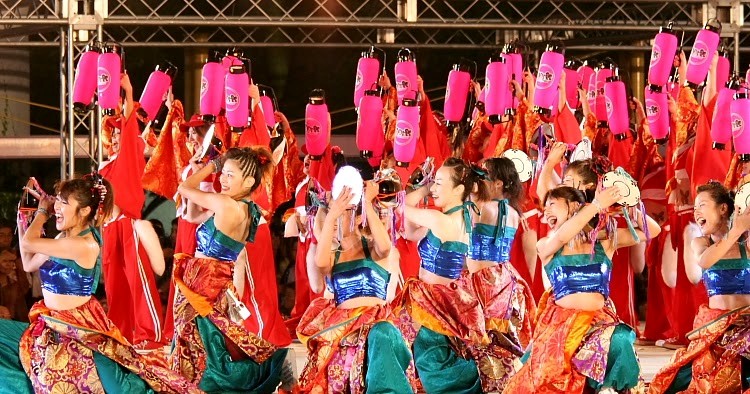
Try to visit during the last weekend of August for the Nippon Domannaka Festival. This event brings large dance groups from all over Japan (many representing universities) who perform across the city. It blends traditional dance costumes and music with contemporary and pop styles that makes for a one-of-a-kind experience, and an amazing spectacle. Okay, it isn’t strictly connected to miso, but it sets the perfect atmosphere for your adventure.
The Mystery of Making Miso
Now, on to find out about miso. The sweet red miso of Aichi prefecture, or Hatcho-miso, is famous across Japan for its unique flavor. And here’s where you can see it being made! A relatively short visit to the outskirts of Nagoya takes you to the Hatcho Miso no Sato (find it on Google Maps at Okandori-52 Hatchocho, Okazaki, Aichi 444-0923). The Meitetsu train line will get you there in 45 minutes, and the factory is a brief walk from Okazaki-koen Station. Try to get there before mid-afternoon because the factory viewing closes at 4:15 pm.
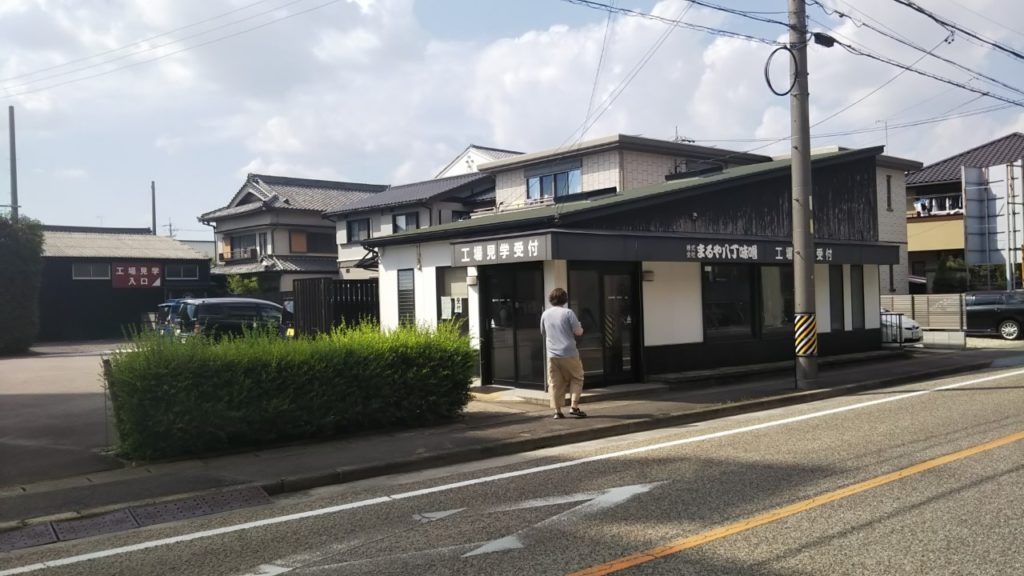
The factory has been around since 1337 and the buildings and neighborhood still try to keep an old Japan feeling. Walking through the factory with a tour guide, you can see the miso in the various stages of processing. The tours are conducted in Japanese but there are enough English signs around so you can catch on to what is said.
The website has an English page as well. The factory also has a little store (of course) but it’s fun to see a variety of ways miso is used, including miso cola! I bought some miso for myself to try at home (I loved it) and some as a travel gift. And it was one of the rare gifts that even got delighted reactions from my Japanese friends!
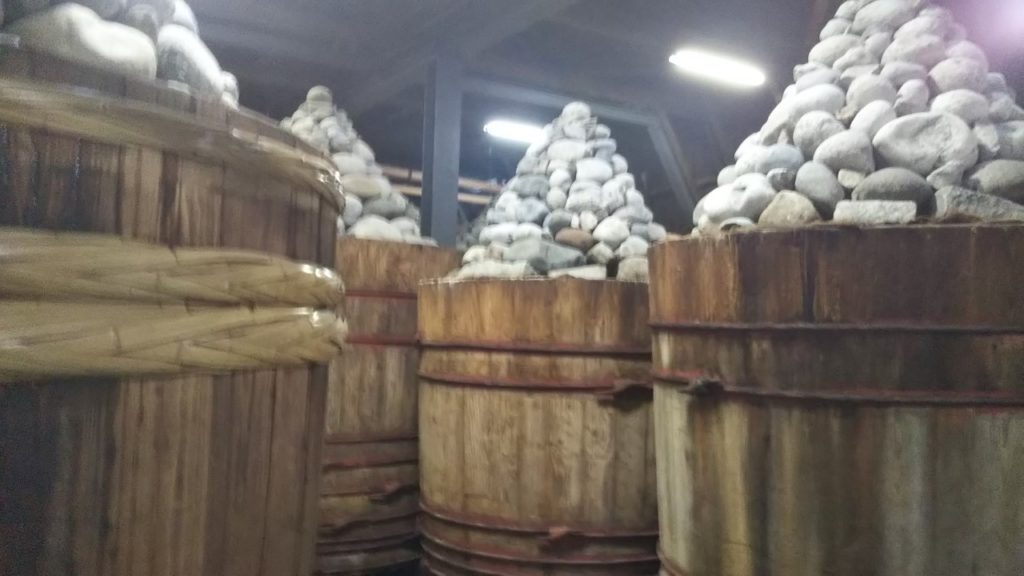
Hungry Yet?
Again, leaving miso behind for a bit, stop off on the way back to central Nagoya at Jingu-mae station and walk directly up to Atsuta Jingu. This is one of the major shrines of Japan, believed to have been founded before 130 AD. It’s said to house the sword Kusanagi no Tsurugi, one of the three ancient symbols and treasures of Japan. Whether that’s true or just a legend, it is still a beautiful and ancient place well worth your time.
Back in Nagoya, it’s time to enjoy Aichi red miso to the fullest. Miso Katsu is the Japanese deep-fried pork cutlet, tonkatsu, smothered in Aichi miso. It’s a dish you will truly enjoy. Try the Miso Katsu Yabuton restaurant for the most famous dish in town. You can also enjoy it with a variety of noodles almost anywhere.
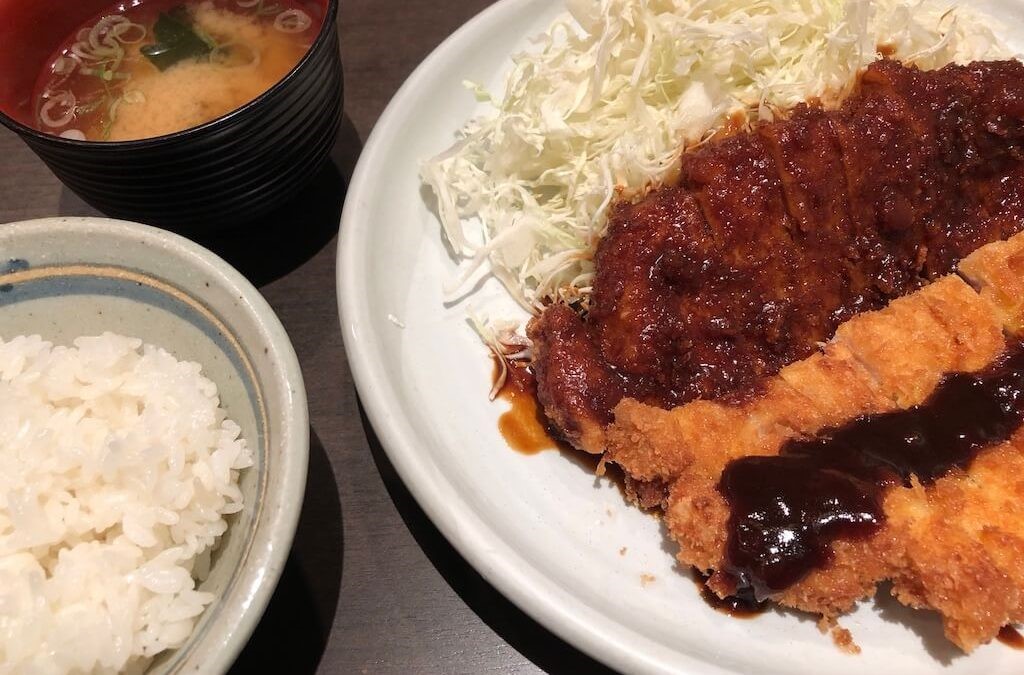
Photo courtesy of Nagoya Foodie https://nagoyafoodie.com/miso-katsu-nagoya/
Any type of miso is a healthy and delicious food that is surprisingly easy to use. You will probably get miso in some form at most Japanese restaurants you try. But if you get the chance, make it an adventure and enjoy the beloved red miso of Aichi prefecture with a fun visit to Nagoya!
For information about trying Miso Katsu:
Nagoya Miso Katsu
https://nagoyafoodie.com/miso-katsu-nagoya/
Photo Credits:
Top Image: othree via Wikipedia, licensed under CC By 2.0
Miso Katsu Image (4) courtesy of Nagoya Foodie
Additional photos provided by Donald Love
All other content (text) created by the original author and © 2020 MUSUBI by Borderlink
Top Image: siamkop via Pixabay
Okayama (岡山) is a beautiful place in Japan, and it is the biggest city in the
Chūgoku region after Hiroshima. Known as the “land of the sunshine”, Okayama’s days are said to be filled with more sun than other prefectures in Japan. Because of this, the city is known for producing many delicious fruits and vegetables! Okayama is particularly famous for its peaches and grapes. Yum yum! If you ever plan a trip, here are 3 very cool locations we recommended checking out!
1) Korakuen Garden
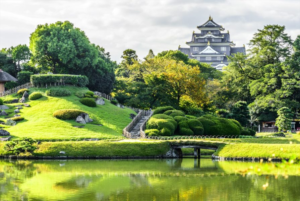
Image Courtesy of Okayama City https://www.okayama-japan.jp/en/spot/91
One attraction you could consider visiting is the Korakuen Garden. Why? It is ranked within the top three landscape gardens in Japan! So if you are into photography, this garden is a must-visit for those Instagram shots! Originally constructed in 1687 by a feudal lord, it was proposed for entertainment where the ruling family could provide a location for receiving guests.
However, there were occasions where the public were allowed to enter the garden. At the end of the feudal era, the public were granted access full-time after the garden became the property of Okayama Prefecture.
Despite undergoing damage from floods and repercussions from wars, the garden have always been restored back to their beautiful state with the efforts of garden designers. What else is there to see? Well, check out the ponds, walking paths, hills and streams. Keep an eye out for the beautiful cherry and maple trees, in addition to the scenic tea leave and rice fields!
2) Okayama Castle
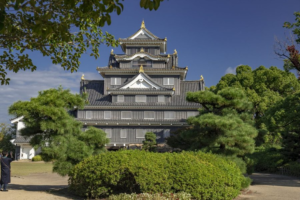
Image Courtesy of Okayama City https://www.okayama-japan.jp/en/spot/776
What’s next? Well you could explore Okayama’s signature castle right after, since it’s so close to the Korakuen Garden! The castle’s black exterior led many people to nickname it the “crow castle”. It was built in the year of 1597, reflecting the Azuchi-Momoyama Period of construction style.
Although the original castle suffered structural damage from World War II, the castle underwent reconstruction from1964 through to 1966. If you do decide to visit, you may notice that the castle is actually on a river (the Asahi River), which was used as a moat.
Within the castle, you can explore the exhibits which illustrate the history and development behind it. You can even try crafting your very own bizen-yaki in the castle’s pottery studio! Bizen-yaki is a pottery style local to the Okayama Prefecture. Or you could dress up in a Kimono and take pictures! If you get hungry, there are even restaurants in the castle. This attraction is definitely one which provides many things to do and see! Excited already?
3) Kibi Plain
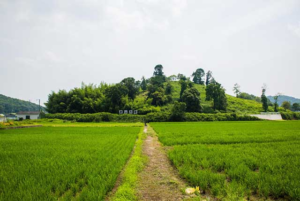 Third, you could visit the Kibi Plain! It is a scenic, rural flatland outside of the central Okayama City. If you prefer cycling over walking, this is the attraction for you! There is a trail made just for cyclers, where you can view the shrines, temples and farmhouses. What a wonderful way to get some exercise into the day!
Third, you could visit the Kibi Plain! It is a scenic, rural flatland outside of the central Okayama City. If you prefer cycling over walking, this is the attraction for you! There is a trail made just for cyclers, where you can view the shrines, temples and farmhouses. What a wonderful way to get some exercise into the day!
The Kibi Plain was once the center of the Kibi Kingdom, which had significant control over the Okayama Prefecture during the 4th century. There are many historical attractions among the plains which you can keep an eye out for, such as burial mounds and shrines.
So if you need some places to add to your travel list, maybe Okayama could be the place for you! Okayama is a wonderful, amazing place to live in and visit! The weather is splendid and perfect for travelers, due to its sunny magnificent atmosphere! And like I said, the local produce and food are just delicious!
These are just three interesting attractions you could visit in Okayama, but you will surely find more if you explore!
Photos provided by Jessica Li. Additional photos provided by pixabay.com
Photo Credits:
Top Image: siamkop via Pixabay
Additional photos provided by Jessica Li. Images (1) and (2) courtesy of Okayama City
All other content (text) created by the original author and © 2020 MUSUBI by Borderlink
Top Image: akiraorc via Pixabay
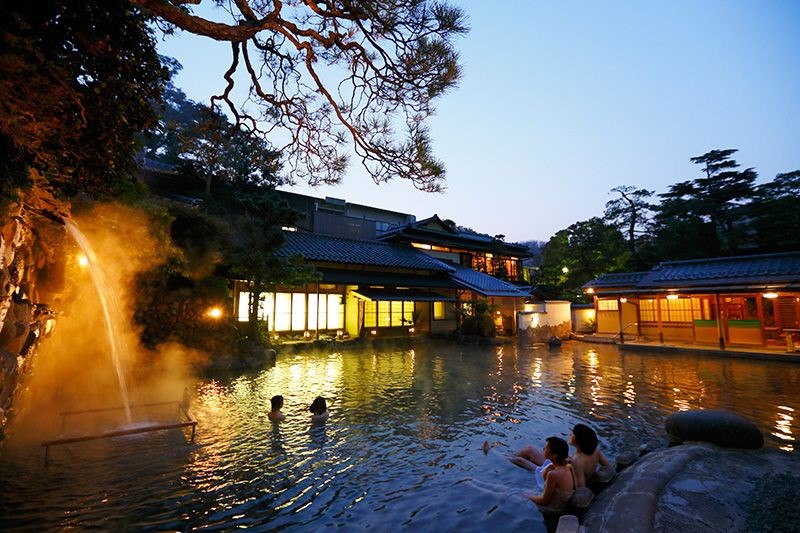
Chōrakuen, one of the hot spring inns representing present-day Tamatsukuri Onsen. Image courtesy of https://www.choraku.co.jp/
Japan retains a unique image in the world for its combination of a healthy diet, good medical system, and the long life expectancy of its people. The Japanese are in fact very cautious in nature and tend to give priority to safety and health. But what is the true secret of the locals’ longevity?
One of the key components that make Japanese life comparatively stable and healthy is the common habit of going to onsen. Onsen, or hot springs, are spread all over the country, and are a popular with people from all walks of life. Be it elderly couples or entire families, chances are someone in Japan is always partaking in these healing waters at any given time. It is said that there are more than 27 thousand hot spring sources all over Japan.
I personally love the onsen in Japan. The waters typically reach a temperature of over 42 degrees, but in different baths one can feel more comfortable with temperatures between 38 and 42 degrees. But what exactly is it that separates onsen from any other bath?
Onsen or Sentō?
There is actually a difference between an onsen and a sentō, or public bath. By definition, onsen use naturally hot water from geothermally-heated springs. Onsen waters typically contain distinctive minerals or chemicals, which the establishments will display for visitors in advance. Onsen can also be both indoors and outdoors, the latter being more common with natural volcanic hot springs to add to the atmosphere.
Sentō on the other hand are generally indoor public bath houses, where the baths are filled with heated tap water. They can be found in a wider range of areas, including in the middle of cities. Larger sentō are sometimes known as ‘super- sentō’ and may be the main source of bathing for those in apartments without a proper bath tub. There is also a difference in price between onsen and a sentō, the latter being the less expensive but less luxurious of the two.
Of course with both, one commonality is that bathers wash themselves before entering the tub; neither onsen nor sentō baths are intended for washing off dirt and grime; that part comes first. The real goal here is a calm, relaxing soak with others.
The Benefits of Onsen
Why are onsen so popular and even important in the Japanese culture and healthy lifestyle of its people? The phrase isshūkan hitomeguri (once-a-week visit) is often used in discussing the therapeutic aspect in hot springs to treat medical conditions and promote health.
Soaking in the waters stimulates the sympathetic and parasympathetic nerves, causing both a rise and then decrease in blood pressure, heart rate, and blood sugar levels. If all that sounds a bit daunting, rest easy; the ultimate effect is establish an equilibrium that helps the body stabilize and heal.
It is said that through this effect, onsen can provide skin and muscle care. The hot waters have positive effects on blood circulation and can help rejuvenate your skin.
It is thought that circulation of the blood stimulated by the hot waters might also improve problems like backaches, shoulder and neck stiffness, and muscle rigidity.
In Conclusion: Taking a Dip
Like many men and women in Japan, I also go to sentō once a week and immerse myself in the heated waters. It may not be an onsen proper, but one can still feel a sense of relaxation and healing. There are many sentō across major cities like Osaka, and they’re very affordable (between 400 and 800 yen). One can even stay there all day!
Nevertheless, I would like to partake in the real deal and go to a full-scale onsen, even if the prices can run much higher (in the 7,000-10,000 yen range). Once considered sacred places where people would go to cure their injuries and diseases, they are still held in high regard as a means of staying healthy and rejuvenated even in today’s world. I too want to go to one of the best onsen in Japan and soak myself in the healing waters of nature itself!
Image courtesy of Chōrakuen. Additional photos provided by pixabay.com
Photo Credits:
Top Image: akiraorc via Pixabay
Additional photo courtesy of Chōrakuen
All other content (text) created by the original author and © 2020 MUSUBI by Borderlink
Works of antiquity such as the Kojiki and Nihonshoki describe Awaji Island as the “birthplace of Japan”. In addition to its place in Japan’s creation mythos, Awaji is famous for something else. Something that, in the hands of a skilled chef, becomes a tasty delight and well worth a trip to the island.
Located in Hyōgo Prefecture, in the eastern part of the Seto Inland Sea between the islands of Honshū and Shikoku, Awaji is a one-of-a-kind locale. When visiting the island, there’s something that you’ll notice right away: there’s a lot of onions! Awaji Onions are considered among the best in Japan, and the island’s beef is said to rival even the world-famous Kobe variety.
So for those planning to make a trek out to this wonderful little island, we highly recommend trying some of the dishes made with these delicious ingredients. One place that we can personally recommend not only has some of the best burgers in the world, but also a one-of-a-kind view.
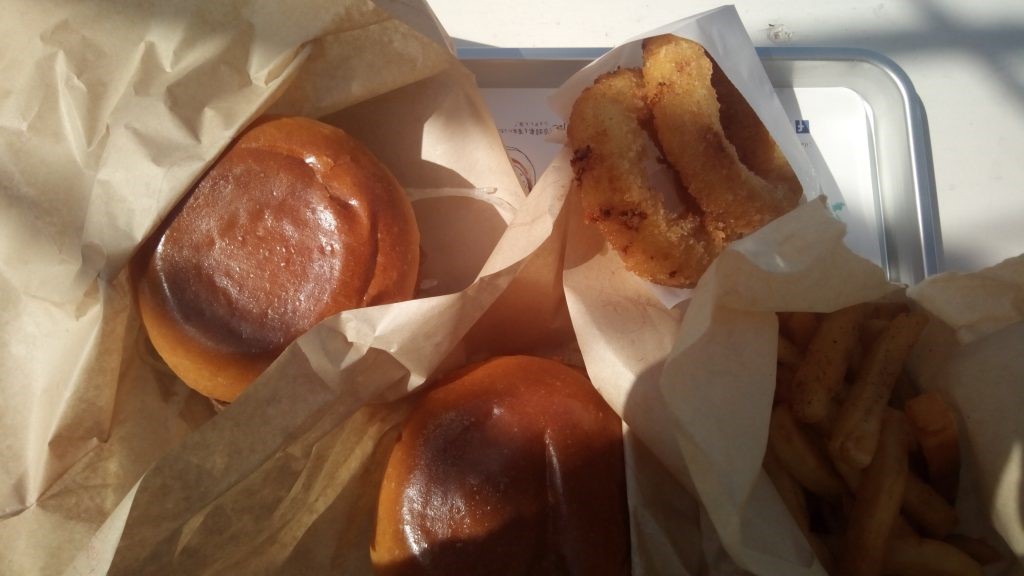
Who’s up for some tasty burgers and onion rings?
For gourmet enthusiasts, burger lovers and those who just and want to see one of the most unique restaurants around, the Awajishima Onion Kitchen is the place to go. The Onion Kitchen is best-known for its Awaji Beef Burger, once selected best burger at the Tottori Burger Festa. Made with local ingredients (the aforementioned beef and onions) and smothered in an onion and tomato sauce made specially to highlight the beef and fried onion ring, this mouth-watering specialty is topped off by a fluffy bun of home-made dough.
The Awaji Beef Burger is joined by various other burger types, some of the best onion rings around, and an indescribably unique desert item: onion ice cream, a unique flavor that makes use of the sweetness of Awaji Onions.
To compliment the taste of this delicious food you can enjoy a great view, as one of the best things about the Onion Kitchen is it location. It’s situated close to the Ōnaruto Bridge, home of the famous Naruto whirlpools. Thus while enjoying the beef burger you can also feast your eyes on the view of the giant Naruto whirlpools under the bridge.
Fun fact: the whirlpools are a result large volumes of water moving between the Seto Inland Sea and the Pacific Ocean between high and low tide, combined with the unique underwater geography of the narrow strait.
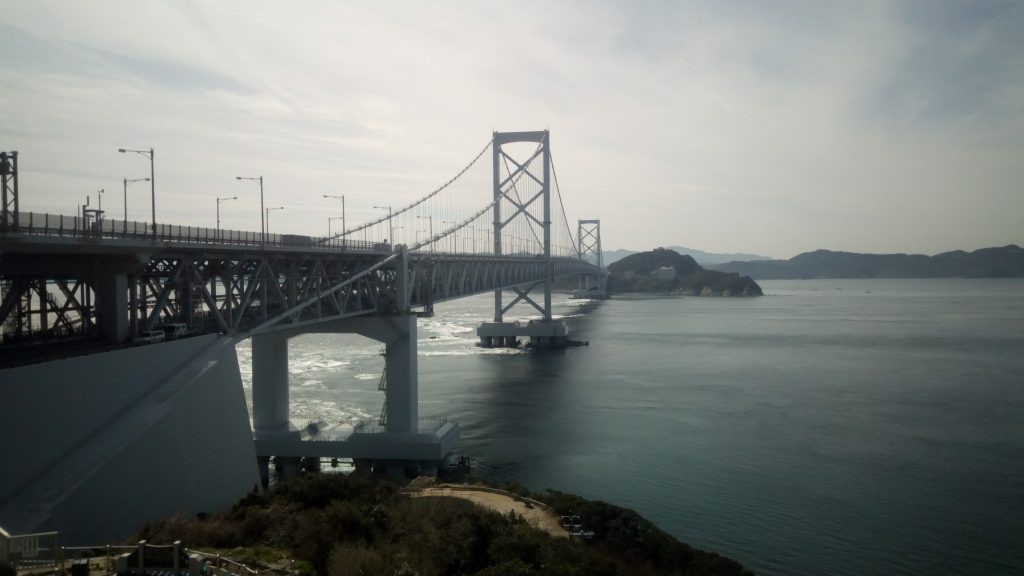
The Ōnaruto Bridge
The whirlpools appear twice daily in the morning and afternoon, so we recommend checking the times before planning your trip to maximize the experience. The whirlpools can grow to up 20 meters in diameter during their peak, and can be viewed from the balcony of the restaurant.
Does all this make you want to hop in the car (or local train) and head on over? The Awajishima Onion Kitchen is an amazing hotspot that combines a true gourmet experience with the wonders of nature. Definitely a destination for food and nature enthusiast alike- try it for yourself!
Photo Credits:
Additional photos provided by Naveed Hussain
All other content (text) created by the original author and © 2020 MUSUBI by Borderlink
Top Image: Schäferle via Pixabay
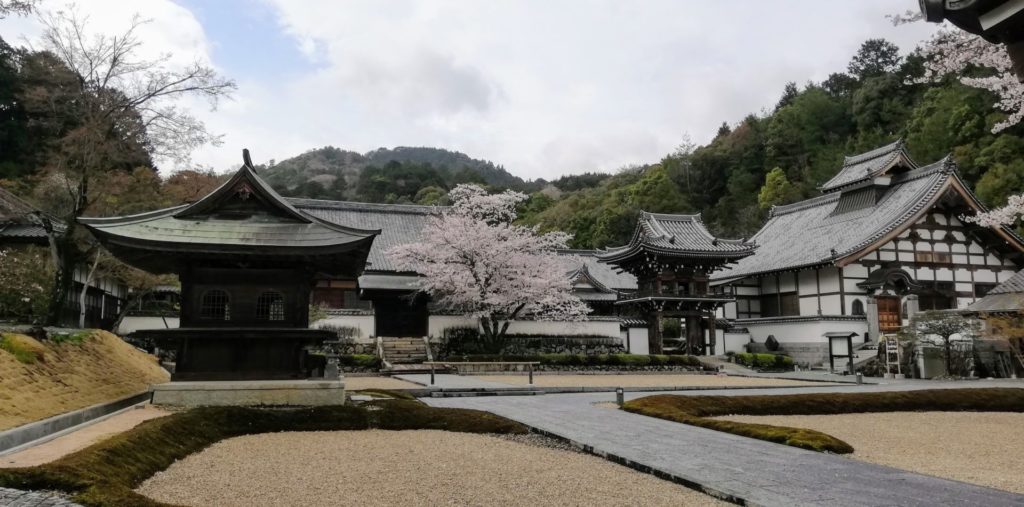
Jyoei-ji Temple & Sesshu’s Garden. Photo by Mark Reid
Buddhist temple in Yamaguchi prefecture.What’s the difference between a shrine and a temple anyway? I have even met a few Japanese people who did not know the answer. And, while some shrines and temples are located next to each other, there is indeed a difference in how they look and what the purpose is.
If you visit or live awhile in Japan, you will no doubt come across quite a few temples and shrines even in the big cities of Tokyo and Osaka. There are about 80,000 shrines all over Japan and about 77,000 Buddhist temples as well (though it is estimated about ⅓ of these will close over the next 25 years). Big and small, they are everywhere.
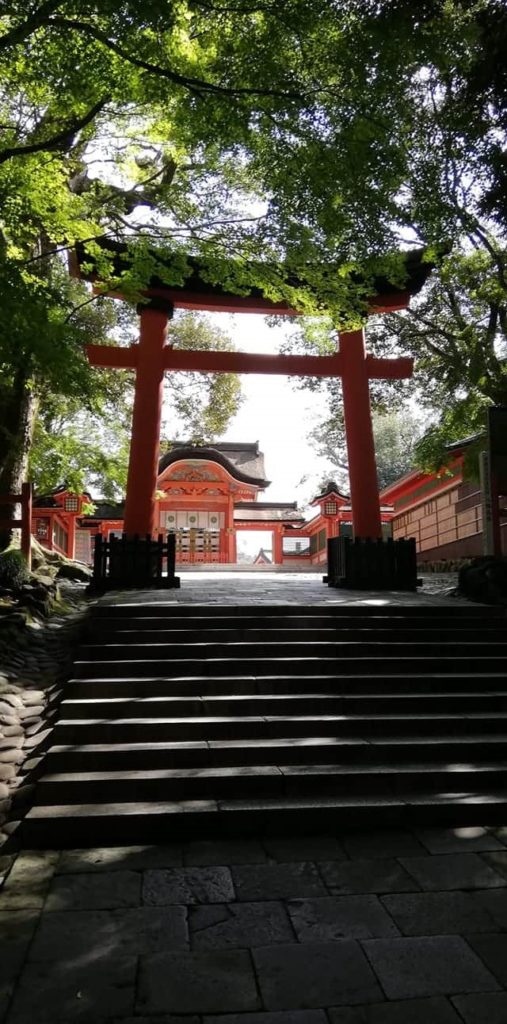
Usa-jingu Shrine in Oita prefecture. Photo by Mark Reid
The most prominent distinctions between shrines and temples are (1) the aesthetics and (2) the actual, technical “religion” (more on this keyword in a moment) being practiced there. As for that first distinction, the clearest difference in appearance is whether or not there is a torii (a “gate” – seen in the pic to the left) at the entrance. Shrines always have them; temples, not so much.
A further distinction in appearance will often be the presence of guardian lion-dogs or other animal statuaries (horses, turtles, etc.). In this way, one might argue that shrines are slightly more entertaining to visit if your interest is in seeing a variety of statues. Shrines sometimes have more colorful buildings than your typical Buddhist temple as well.
However, if it is spiritual enlightenment you are seeking or just want to calm the mind, temples might be your thing. The other key difference between shrines and temples is in the purpose of each. While both might be considered places of worship, shrines house kami (sacred relics stored deep inside that cannot be viewed by the public) related to Shintoism.
On the other hand, temples have more of an altar with a statue of a Buddha (sometimes, but not always) as the centerpiece. While a discussion on the variety of distinctions between Shintoism and Buddhism could fill several volumes of texts, in a nutshell, Shintoism views the world as everything having a “spirit,” even inanimate objects.
Those who worship at shrines might be considered more “superstitious” to some extent (e.g., you can buy good luck charms at a shrine or have a Shinto priest bless your car for safer travels). At Buddhist temples, there is more of a concentration on practicing self-development. At some temples you can arrange to practice zazen (a meditative practice to still the mind and accept the nature of things for what they are). Regardless of your own personal beliefs, the good news is you are welcome to visit a shrine or temple in Japan either way.
So, why the confusion? Well, for starters, the buildings do kind of look the same. As both Shintoism and Buddhism flourished side by side for hundreds of years, many practices and the architecture of their structures itself began to meld and resemble each other. Likewise, the worship procedure is essentially the same between shrines and temples: bow-bow, clap-clap, bow.
These can vary according to some specific locales, but in general if you don’t see a sign indicating the particular “flow” of worship, you’ll be fine using that B-B-C-C-B method. Another fun similarity is in the accumulation of stamps you can get. Called goshuin most large shrines and temples will stamp your goshuincho (stamp book for this purpose) for around 300-500 yen. And there’s no rule against or problem with collecting your shrine and temple stamps together in this book.
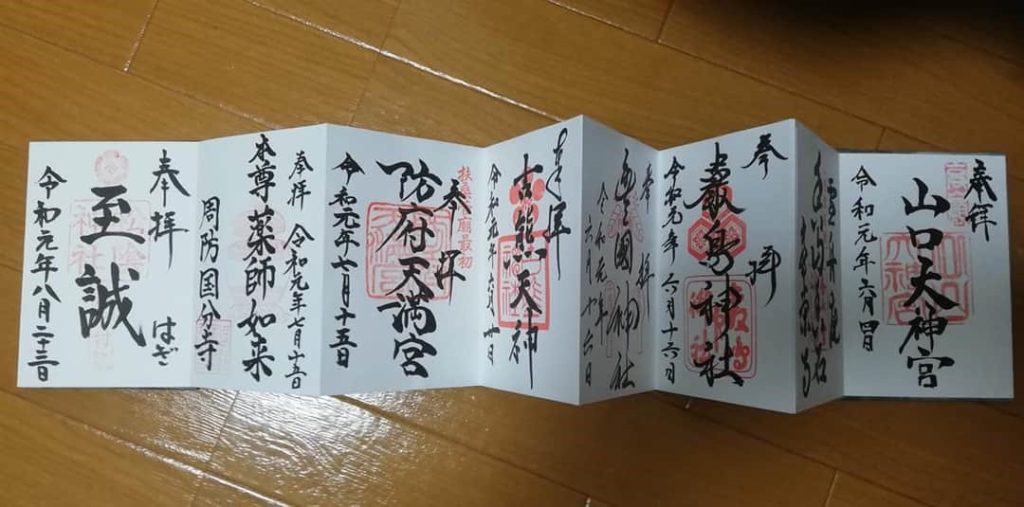
Goshuin stamps, personal collection. Photo by Mark Reid
From sumo to sushi, there are many wonderful, fascinating things that are definitively Japanese. Essential to any significant time spent in Japan will invariably involve a trip to a Shinto shrine or a Buddhist temple. Whether you go simply to take that great iconic photo of the complete Japanese experience or are seeking personal enlightenment, a trip to a shrine or temple is always worth it.
Photo Credits:
Top Image: Schäferle via Pixabay
Additional photos provided by Mark Reid
All other content (text) created by the original author and © 2020 MUSUBI by Borderlink
